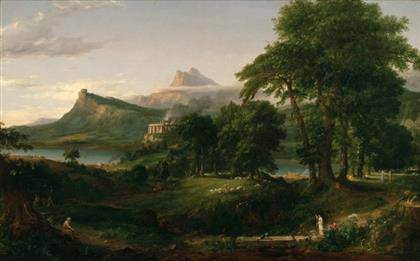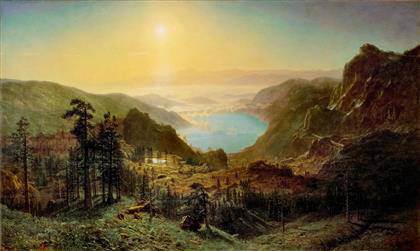
Thomas Cole
The Course of Empire: The Arcadian or Pastoral State
c. 1834-1836
Oil on canvas
New-York Historical Society
Gift of The New-York Gallery of the Fine Arts, 1858.1

Albert Bierstadt
Donner Lake from the Summit
1873
Oil on canvas
New-York Historical Society
Masterpieces from the Hudson River School at LACMA The Los Angeles County Museum of Art (LACMA) presents ‘Nature and the American Vision: The Hudson River School’, showing the New-York Historical Society’s premier collection of 19th-century American landscape paintings. December 7, 2014 – June 7, 2015.]]>
Source: The Los Angeles County Museum of Art
Drawn entirely from the New-York Historical Society, this exhibition features 45 paintings and represents 23 renowned artists who led the American landscape movement, including Thomas Cole, Asher Brown Durand, Frederic Edwin Church, and Albert Bierstadt, among others.
“Nature and the American Vision” also examines the movement beyond the Hudson River, with works by artists who reflected both realistic and romantic attitudes toward nature in scenes of New England, the American West, and South America. For the first time on the West Coast, all five paintings that compose Thomas Cole’s series The Course of the Empire (c. 1834-36) are on view. “Nature and the America Vision: The Hudson River School” is curated by Dr. Linda S. Ferber, Senior Art Historian and Museum Director Emerita at the New-York Historical Society.
Originating high in the Adirondack Mountains, the Hudson River served as a vital military and commercial waterway, commanded over the centuries by Native Americans, the Dutch, and then the English until the American Revolution. Such associations enriched the visually evocative terrain of the Hudson River Valley and New England, producing schools of painting and literature grounded in specific scenery and history. Hudson River School artists would eventually seek inspiration farther from home, in places such as California’s Yosemite Valley and the Andes in South America.
Artists of the Hudson River School used traditional techniques to create large, scenic landscapes that evoked a sense of adventure while documenting a vast new territory, including natural wonders, forests, commanding mountain ranges, roaring rivers, and miles of rich land for agriculture. As this notion became popular, national and local pride stimulated the development of an American Grand Tour, celebrating a medley of sites knows for their picturesque and sublime qualities.
Related content
American Landscape Painting at Grand Rapids Art Museum (exhibition, 2013-2014)
Follow us on:


